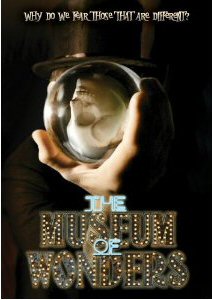
Life backstage at the titular theatre, a circus-type show offering a mix of the traditional and more contemporary, is as turbulent as it is colourful. Off-duty clowns quarrel with sword-swallowers, while fortune tellers can’t help but foresee doom wherever they look.
The show’s owner, dwarf Marcel (Fabiano Lioi), is largely oblivious to all of this. He’s smitten with beautiful red-headed dancer Salome (Maria Rosaria Omaggio), you see. She has little interest in him – until she learns that he has inherited a fortune.
Soon, Salome and her secret lover, the bearded strongman Sansone (Francesco Venditti), have hatched a plan that involves relieving love-struck Marcel of his wealth. All Salome has to do is make sure the little fellow falls for her charms …
THE MUSEUM OF WONDERS opens to the image of a pasty face staring at us from the centre of a night sky’s moon, instantly recalling the work of cinematic pioneer Georges Melies.
The camera then withdraws to reveal it as part of a stage act, a heavily made-up woman crooning a song about unrequited love in front of a blue velvet curtain and the moon-based backdrop.
The song ends, a fog engulfs the stage. When it clears, the woman has gone to be replaced by a clown-faced ventriloquist performing to an auditorium of empty seats.
All of this occurs in the first two minutes, while the opening credits are still rolling out. Already we’ve had flashes of Melies, David Lynch, Federico Fellini, Alexandro Jodorowsky and even Rinse Dream.
And there are plenty more references to come … forays into opera are shot in the same manner as Dario Argento, while the set designs and beautiful framing of scenes often bring Peter Greenaway’s elegance to mind. Dream sequences manage to evoke both Luis Bunuel and Jean Rollin in equal measures, while the deliberate broadness of the performances suggests theatricality much in keeping with cinema’s silent era.
So, yes, director Domiziano Cristopharo certainly wants us to know how well-read in the history of film he is. So much so that this often runs the risk of becoming a simple case of ‘all style, no substance’.
And, no amount of camp humour, relentless weirdness and even a cameo from Ruggero Deodato as a bumbling waiter can distract from the fact that the plot, what there is of it in-between the pathological oddness and grating circus-themed score, is a blatant rip-off of Todd Browning’s FREAKS.
However, I’m not willing to dismiss THE MUSEUM OF WONDERS. It’s too long at 102 minutes in length, yes. It’s up its own arse and suffers from a coldness brought about by its unerring need to be ‘clever’, certainly. But, as with Cristopharo’s previous HOUSE OF FLESH MANNEQUINS, WONDERS is beautifully shot and undeniably dripping in ambition.
Each composition is immaculately framed, with mirrors featuring heavily throughout. The use of colours, smoke and stage props are extraordinary, making this a superbly shot film if nothing else. Even the FX are good – although, scenes such as the one where a character has a clock ripped out of his chest are too reminiscent of THE HOLY MOUNTAIN for comfort.
The whole thing just fails to hook as drama. It’s tiresome as a result. But, it’s awfully nice to look at along the way.
The disc from Elite Entertainment’s sub-label MVD Visual is a region free affair. It presents THE MUSEUM OF WONDERS uncut in its original aspect ratio of 1.85:1, enhancing the picture for 16x9 television sets.
Images are sharp and there is a healthy balance of contrast throughout. Tones are natural and often striking; while the ambitious set design is given ample opportunity to impress through the colourful transfer here. There is a very filmic look to proceedings, with a slight wear on the palette that appears to be intentional, lending the film a well-judged appearance of age.
The 2.0 Italian audio track provided is a solid if standard track: it won’t blow you away but, unless that’s specifically what you’re looking for, you won’t much care. Optional English subtitles are well-written and easily readable at all times.
The disc opens with a static main menu page. From there, a static scene-selection menu allows access to the film via 10 chapters.
Extras begin with a 6-minute elongated sequence of Murrugun the Mystic on the stage, doing what he does best – breathing fire and swallowing swords.
Then we get 18 minutes of outtakes. These range from inappropriate bursts of laughter from both cast and crew members, to scenes of props behaving badly. They make for a moderately entertaining watch. At the very least, they prove the shoot to be lighter than the end product suggests.
Finally we get 9 minutes of deleted scenes. These are mostly made up of additional dialogue, but add little to the overall story.
All extras are presented in 16x9 widescreen. The deleted footage comes with Italian 2.0 audio and optional English subtitles, while the remainder doesn’t rely much on dialogue.
THE MUSEUM OF WONDERS is well served by Elite’s disc. The film itself is an intriguing proposition, an arty oddity that – some obvious genre traits aside - feels somewhat displaced in the current Century, such is its yearning to associate itself with the filmmakers that inspired its styles.
Someone give this a director a script capable of reining in his undeniable talents (and lay off the constant referencing of past masters, Dom!), and he truly could produce something brilliant
Review by Stuart Willis
| Released by Elite Entertainment |
| Region 1 - NTSC |
| Not Rated |
| Extras : |
| see main review |